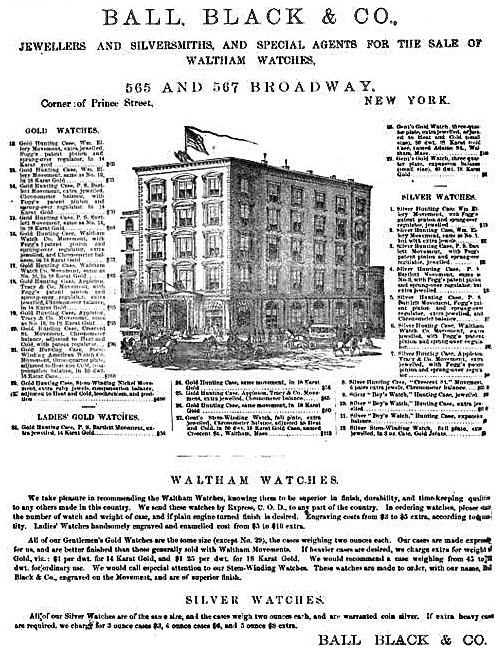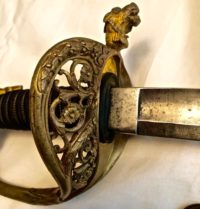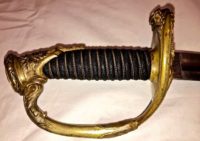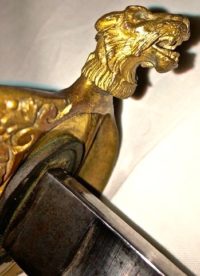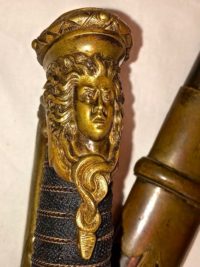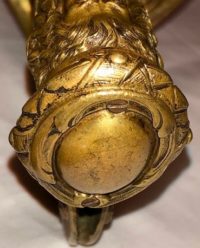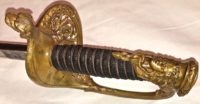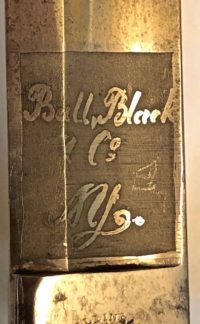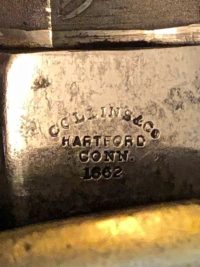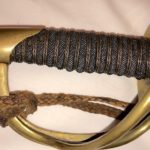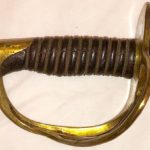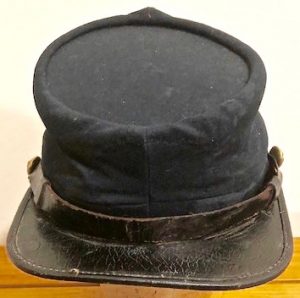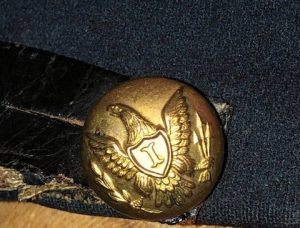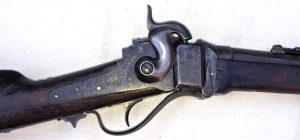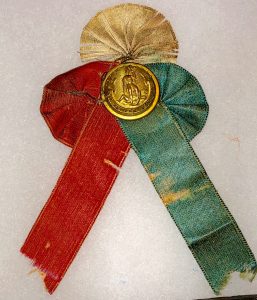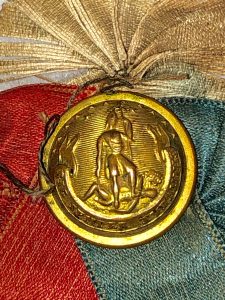High Grade Civil War Officer’s Presentation Sword with Ornate Elements
SOLD
High Grade Civil War Officer’s Presentation Sword with Ornate Elements – This superior quality Civil War presentation grade, foot officer or staff and field sword is a superior example of a high end, period sword. The hilt is covered with shagreen or rayfin, wrapped with two strands of twisted, brass wire. The pommel, quillon and knucklebow are works of casting art – they exhibit multiple decorative elements, including a Medusa-like bust, lion or wolf’s head and other high relief aesthetic features. The browned steel scabbard exhibits brass fixtures, in a field and staff style. The blade, is marked on the ricasso, with the maker’s name – “COLLINS & CO HARTFORD CONN. 1862”; above the ricasso and the Collins marking, is the acid etched name of the high end, war period purveyor of fine silver – “Ball, Black & Co NY.” We believe that this sword, constructed by Collins, was embellished and the blade etched by Ball, Black & Co. The blade is beautifully etched with various patriotic motifs. This sword is in excellent condition.
Measurements: Overall length – 38 “; Blade length – 31 “
From “The Daytonian in Manhattan”:
“By 1860 the fashionable shopping district of New York had migrated northward to the blocks on Broadway just south of Houston Street. The magnificent St. Nicholas Hotel engulfed the entire block between Broome and Spring Streets and upscale merchants built impressive structures to lure wealthy shoppers—Tiffany & Co. had already been at 550 Broadway for nearly a decade.
It was time for Tiffany’s rival, Ball, Black & Co., to move north from 247 Broadway as well. Among other articles, the company produced and sold jewelry, silver objects, clocks, decorative furniture and chandeliers. Founded in 1810, the company was originally located at 166 Broadway and was considered the jewelry store of New York City. As its successful business grew and as commerce moved northward up Broadway, the store had changed addresses three times. Ball, Black & Co. was ready to move again.
John A. May was a manufacturer of umbrellas, but he dabbled in real estate as well. In 1860 he commissioned architect John Kellum to design a building specifically for the use of Ball, Black & Co. Completed a year later, it was a six-story show-stopper of East Chester marble.
Kellum craftily set the sixth floor back from the vision line so that it was invisible from the street, creating the necessary, classic proportions. In 1868 William Leete Stone described the building as “magnificent” and “justly ranking among our finest specimens of architecture.”
The store was opened on July 1, 1860 “with great splendor and éclat.” The structure was not only beautiful, but innovative. Touted as the first “absolutely fire-proof” building in New York, the vaults below street level contained the first safe deposit system in the United States. The single-sheet panes of plate glass imported for the first floor windows—14 feet, 8 inches tall and 9 feet, 2 inches wide—were thought to be the largest ever made. Certainly they were the largest ever brought to the U.S.
Steele wrote “In proportion, in chasteness of design, in rich and elegant finish, and in perfect keeping, we know of no building in the whole length of Broadway that can equal it…The first story is pure Corinthian, carried out in its details from the base to the summit of the entablature. The upper stories are Italian, but so ornamented as to be in keeping with the main story and to give a pleasing uniformity to the whole structure.”
The entrance doors were designed so that when opened they would form decorative sides to the vestibule. They boasted carved moldings and green bronze rosettes, designed to the specifications of Ball, Black & Co. Inside, the “Grecian style predominates, and is treated in a rich, chaste and original manner,” reported Steele. “The fittings, which are very beautiful, are composed of panels of rightly-stained wood and gold. A series of cabinets extend along the south wall, forming one continuous design by means of arches, under which are elegant vases. The whole appearance is rich and elegant in the extreme.”
The first floor was exclusively for the sale of jewelry—diamonds and other gems, watches and silverware. Ball, Black & Co. advertised that the “stock of diamonds in this store is among the largest in the world, offering a vast selection of the costliest gems of the finest water and the rarest cutting.”
A marble staircase took the shopper to the second floor where artwork and clocks were displayed. Steele reported on “a gallery of fine paintings, rare specimens of the Italian, Flemish and German schools” and “a wilderness of rich clocks, bronzes, marble statuary, and splendid mantel ornaments of every kind, together with superb porcelain ware of Sevres, Dresden, and Berlin Royal Manufactories.”
On the third floor could be found chandeliers and gas fixtures. Many of these were manufactured on the premises while others were imported from France and England.
The top three floors housed the manufacturing and workroom spaces. Jewelry was made here, diamonds set, watches repaired and tableware was gold or silver plated. The company employed over 300 works including designers, engravers, chasers and modelers.
The store was opened on July 1, 1860 “with great splendor and éclat.” The structure was not only beautiful, but innovative. Touted as the first “absolutely fire-proof” building in New York, the vaults below street level contained the first safe deposit system in the United States. The single-sheet panes of plate glass imported for the first floor windows—14 feet, 8 inches tall and 9 feet, 2 inches wide—were thought to be the largest ever made. Certainly they were the largest ever brought to the U.S.
Steele wrote “In proportion, in chasteness of design, in rich and elegant finish, and in perfect keeping, we know of no building in the whole length of Broadway that can equal it…The first story is pure Corinthian, carried out in its details from the base to the summit of the entablature. The upper stories are Italian, but so ornamented as to be in keeping with the main story and to give a pleasing uniformity to the whole structure.”
The entrance doors were designed so that when opened they would form decorative sides to the vestibule. They boasted carved moldings and green bronze rosettes, designed to the specifications of Ball, Black & Co. Inside, the “Grecian style predominates, and is treated in a rich, chaste and original manner,” reported Steele. “The fittings, which are very beautiful, are composed of panels of rightly-stained wood and gold. A series of cabinets extend along the south wall, forming one continuous design by means of arches, under which are elegant vases. The whole appearance is rich and elegant in the extreme.”
The first floor was exclusively for the sale of jewelry—diamonds and other gems, watches and silverware. Ball, Black & Co. advertised that the “stock of diamonds in this store is among the largest in the world, offering a vast selection of the costliest gems of the finest water and the rarest cutting.”
A marble staircase took the shopper to the second floor where artwork and clocks were displayed. Steele reported on “a gallery of fine paintings, rare specimens of the Italian, Flemish and German schools” and “a wilderness of rich clocks, bronzes, marble statuary, and splendid mantel ornaments of every kind, together with superb porcelain ware of Sevres, Dresden, and Berlin Royal Manufactories.”
On the third floor could be found chandeliers and gas fixtures. Many of these were manufactured on the premises while others were imported from France and England.
The top three floors housed the manufacturing and workroom spaces. Jewelry was made here, diamonds set, watches repaired and tableware was gold or silver plated. The company employed over 300 works including designers, engravers, chasers and modelers.


















